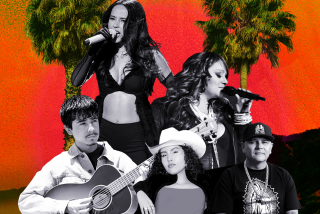Movies and Bullfights Are Spice of Life for S.D. Border Straddler
The idea was to kidnap John Wayne.
“We were in Texas filming ‘The Alamo.’ One day at lunch I made the suggestion to a bunch of the Mexican extras working in the picture as Santa Anna’s troops. I didn’t tell them I was kidding.
“I said, ‘Look. Texas belonged to Mexico. It was literally stolen from us. What I’m going to propose to you is dangerous, so if you want to forget it, OK. . . .’
“ ‘I can get live ammunition. . . .’ At this point, everyone became very tense. I told them: ‘We get this tall guy--what’s his name? Win? Wino? We kidnap him and contact Washington. We’ll give him back if the United States will give us Texas back.’
“One colonel said he had a family to think of. Another said the U.S. Army was only two hours away and, ‘They’ll wipe us out.’ I said, ‘Yes. But we’ll die as heroes.’ The next day I had lunch alone.”
The speaker was Ruben Dario Padilla Colon y Magallanes, a longtime San Diegan reminiscing about a kaleidoscopic and sometimes fascinating life on both sides of the U.S.-Mexican border.
An interview related to Padilla’s 80th birthday evoked memories of those deeds that have entertained him, from his career in the film industry to wearing pistol and badge as police chief of Texcoco, to working in tourism and politics and publicity in San Diego and Baja California Norte, and more.
In his milieu, “everyone,” it seems,
knows Padilla, and he knows “everyone.” He is one of those binationals common along the border, but nothing is common about him. Padilla is a gregarious, knowledgeable, humorous character, quick with a joke, a fact or a connection, a man known to be able to get the job done or send you to someone who can. He can even get you out of jail with a phone call, two at the most (Tijuana or Mexicali only).
In “The Alamo,” Padilla portrays Gen. Antonio Lopez de Santa Anna, leading his soldiers at San Antonio against defenders holed up in the old mission called The Alamo. It was filmed in 1959 near Brackettville, Tex.
“I didn’t have many lines,” Padilla said, “but Santa Anna is referred to all the way through, so he’s a major character.”
And of course he had to ride a white horse, as was Santa Anna’s custom. Former Texas Gov. Price Daniels provided his horse, White Cloud. Ruben Padilla had never ridden.
At the moment Santa Anna was to appear at the head of his troops, Michael Wayne, the actor’s son, told Padilla, who was wearing an authentic 1836 Mexican army uniform: “You’d better mount.”
“Mount what?” Padilla asked. “I’ve never ridden before.”
“You’d better tell Dad.”
Padilla said, “You tell him.”
Eventually, Padilla learned to manage on horseback, although once during a charge he fell.
“All I heard was, ‘Cut, cut, cut,’ ” Padilla said. “And I never heard so much cussing (from John Wayne) in my life.”
Padilla, originally a researcher for the film and assistant to the producer, was selected for the role in a compromise.
“It’s a cameo part, so they needed someone famous or an unknown. Marlon Brando turned it down. Then they got a young fellow locally.”
But Richard Widmark and Laurence Harvey, also in the film, objected because of the candidate’s youth. Someone mentioned that Padilla had acting experience. Padilla continued:
“John Wayne said, ‘He doesn’t look like Santa Anna.’ I told him, ‘You don’t look like Jim Bowie, either.’ ”
Another cameo role was filled by the famed bullfighter, Carlos Arruza, who portrays a Mexican lieutenant delivering a message to Bowie, Travis, Crockett and the others.
Singer Pedro Vargas refused the role. So Padilla, for many years one of Arruza’s best friends, arranged for the matador to handle it. “Arruza got $20,000 for the part.”
Much of Padilla’s life has centered around movie making and bullfighting. Friends in one field often led him to the other in a glamorous and pleasant ricochet. The pattern for this life may have been cut by Padilla’s father, Dario, a Mexican importer-exporter who was a friend of the first great Mexican bullfighter, Rodolfo Gaona.
However, for Ruben Padilla, born in Guadalajara on Feb. 16, 1910, the first personal step was his fast friendship with another star matador, Silverio Perez, whom he met in the early 1940s at Mexicali, where Silverio--immortalized in song and politics as well as in the taurine world--was fighting.
Padilla lived across the border in Calexico, where the family had moved in 1923 after spending four years in San Francisco to avoid the terrors and confusions of the Mexican Revolution.
Later, at Hotel Caesar in Tijuana after a bullfight in the early 1940s, Padilla introduced Perez and other matadors to producer-director Budd Boetticher.
“Budd had a script, “Torero,” which became “The Bullfighter and the Lady,” Padilla said. ‘Wayne had just finished ‘Sands of Iwo Jima’ and had quite a bit of money. Budd contacted him about financing the movie, and Wayne was interested. He called me at Calexico (to arrange for bullfighters). He was very concerned about how much the matadors would have to be paid.
“I said, ‘Yes, Mr. Wayne?’ ” And in that slow resonant voice, Wayne told Padilla: “My friends call me Duke.” And that started a friendship that ended only with Wayne’s death in 1979.
Padilla arranged for the matadors. And so Wayne financed “The Bullfighter and the Lady” with a $450,000 budget (“A lot of money then,” Padilla said). Padilla portrayed the impresario in a cast that included Robert Stack, Gilbert Roland, Katy Jurado and Virginia Grey. It was filmed in Mexico City. Naturally, there was an occasional party.
“Stack liked the sauce made from maguey worms until we told him what it was.”
Padilla portrayed Pedro in Boetticher’s film “Wings of the Hawk,” starring Van Heflin; was adviser for the bullfight sequence in “Mexican Hayride” with Abbott and Costello; was assistant to the producer in “The War Wagon,” filmed in Mexico with Kirk Douglas; was in Boetticher’s documentary, “Arruza,” narrated by Anthony Quinn, whom Padilla met at Hotel Caesar, naturally, “in the early 1940s,” and enjoyed his most important role as the detective in the Mexican-Italian movie “Bus Ride.”
Padilla enjoyed a brief taurine career as bullring judge at Mexicali and Tijuana, twice having matadors arrested for allowing picadors to abuse bulls. And, in the 1950s, at San Diego’s Balboa Stadium, he staged what was probably the first bloodless bullfight in California.
Along the way he helped a young American woman obtain her start in the entertainment world.
“It was in the early 1940s,” Padilla said. “The manager of the Hotel de Anza in Calexico called me. He said he had a problem with a guest, a young girl who hadn’t paid her bill in three weeks. ‘She says she has a contact.’
“So I went to her room. Her name was Yolanda Warren. She was a beautiful girl, a brunette, about 16 or 17. I read the contract. It was for a nightclub that didn’t exist. But she had to go to Mexico City to make a success of herself. I took her to eat. I advised her against going. . . . “
But Warren, from Washington state, was determined to make her mark in the Mexican capital. Padilla contacted Silverio Perez, who was fighting in Mexicali on the following Sunday. One of the matador’s assistants could drive Warren to Mexico City as he returned.
“On Tuesday she called me from El Paso. The assistant wanted to place her in a brothel. I gave her some phone numbers in Mexico City and wired her some money.”
On her own, she obtained a job dancing at a cheap cabaret in Mexico City. Her style was Tahitian. One night an important politician, out slumming, was attracted to her. He tore some big bills in half and sent one set of the halves to her.
“She spurned him. There was a big scene, big headlines in the papers. The cabaret became famous, and she did too.”
In fact, using a name that complemented her sensuous movements, she became the most famous dancer in Latin America and Asia: Tongolele. (Now living in Mexico City as Yolanda Montes, Tongolele made a guest appearance last fall at a benefit for ailing bandleader Perez Prado. Her old movies are on Channel 12.)
Although the matador Silverio was unable to help Padilla in the Tongolele episode, he arranged for his friend’s only experience in law enforcement. It was in the winter of 1967-68, during one of Silverio’s three terms as mayor of Texcoco, the small and historic town that had been home to Netzahualcoyotl, the cultured Chichimeca king and poet crowned there in 1428.
“Silverio appointed me police chief to bring tourism from Mexico City,” Padilla said. “Fortunately, I had a great assistant chief. One night there was a shooting at a dance. A couple of brothers killed a couple of other men. I suggested sending out a posse. The assistant chief suggested taking it easy. He said the killers weren’t professionals, that they had family in Texcoco, that we should play it cool.
“In a month they were spotted in a local market. I didn’t go for them. I all of a sudden had a cold.”
The assistant chief arrested the pair without a fight.
For a six-year term starting in 1953, when Baja California Norte became a state, Padilla was the first state tourism director. In that capacity, he often arranged front-row bullfight seats for Quinn, Orson Welles and other Hollywood personalities. Simultaneously, Padilla was secretary general of the “middle-class” sector for Mexico’s ruling political party.
Now he lives in Mission Hills, an easy walk to the shops and restaurants in the vicinity of Goldfinch and Washington streets, directs U.S. publicity for the Tijuana bullfights and keeps in touch with his family, including brother Oscar, well known in local politics and in the insurance business; son Ruben Jr., also an insurance executive; son Marco Antonio, a U.S. Customs inspector; and two granddaughters and three grandsons, including Ruben, a magician.
Padilla, who retained his Mexican citizenship, critically observes activities major and minor on both sides of the border. For instance, on the Tijuana traffic circles called gloriettas:
“Approach them according to your machismo and the weight of your vehicle.”
On the future of Tijuana:
“There is really a new Tijuana now. Tourists should feel no qualms about visiting. . . . The main problem is lack of water.”
And he denigrates use of the words “Hispanic” and “Chicano” to describe Mexicans or Mexican-Americans--Hispanic because it belongs rightly to Spaniards only, he says, the other because it is recently coined and of uncertain origin. He is a Mexican, he will tell you, descended from Spaniards and Indians.
More to Read
Only good movies
Get the Indie Focus newsletter, Mark Olsen's weekly guide to the world of cinema.
You may occasionally receive promotional content from the Los Angeles Times.










